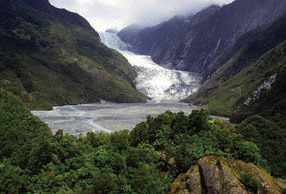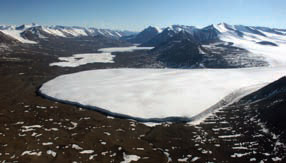


Glaciers and climate
Glaciers generally form where snow deposited during the cold/humid season does not entirely melt during warm/dry times. Temperate glaciers not influenced by thick debris cover, calving or surge instabilities are recognised as being among the best climate indicators as their reaction or change provide a signal that is easily understandable to a wider public.
Glaciers form where snow is deposited during the cold/humid season and does not entirely melt during warm/dry periods. This seasonal snow gradually densifies and transforms into perennial firn and finally, after the interconnecting air passages between the grains are closed off, into ice (Paterson 1994). The ice from such accumulation areas then flows under the influence of its own weight and the local slopes down to lower altitudes, where it melts again (ablation areas). Accumulation and ablation areas are separated by the equilibrium line, where the balance between gain and loss of mass is exactly zero. Glacier distribution is thus primarily a function of mean annual air temperature and annual precipitation sums modified by the terrain which influences, for example, the amount of incoming net radiation or the accumulation pattern.

Fig. 1 Franz-Josef Glacier, New Zealand, is a temperate valley glacier in a maritime climate descending into rain forest.
Source: M. Hambrey, SwissEduc (www.swisseduc.ch).
In humid-maritime regions, the equilibrium line is at (relatively) low altitude with warm temperatures and long melting seasons, because of the large amount of ablation required to eliminate thick snow layers (Shumskii 1964, Haeberli and Burn 2002). ‘Temperate’ glaciers with firn and ice at melting temperature dominate these landscapes. Such ice bodies, with relatively rapid flow, exhibit a high mass turnover and react strongly to atmospheric warming by enhanced melt and runoff. Features of this type are the Patagonian Icefields and the ice caps of Iceland, as well as the glaciers of the western Cordillera of North America, the western mountains of New Zealand (Fig. 1) and Norway. The lower parts of such maritime-temperate glaciers may extend into forested valleys, where summer warmth and winter snow accumulation prevent development of permafrost. In contrast, under dry-continental conditions, such as in parts of Antarctica (Fig. 2), northern Alaska, Arctic Canada, subarctic Russia, parts of the Andes near the Atacama desert, and in many Central Asian mountain chains, the equilibrium line may be at (relatively) high elevation with cold temperatures and short melting seasons. In such regions, glaciers lying far above the tree line can have polythermal as well as cold firn/ice well below melting temperature, also a low mass turnover, and are often surrounded by permafrost (Shumskii 1964).

Fig. 2 Commonwealth Glacier, Taylor Valley, Antarctica, is a cold glacier in a continental climate (10 January 2007). In the background Canada Glacier and frozen Lake Fryxell are shown. Source: D. Stumm, University of Otago, New Zealand.
The reaction of a glacier to a climatic change involves a complex chain of processes (Nye 1960, Meier 1984). Changes in atmospheric conditions (solar radiation, air temperature, precipitation, wind, cloudiness, etc.) influence the mass and energy balance at the glacier surface (see Kuhn 1981, Oerlemans 2001). Air temperature thereby plays a predominant role as it is related to the long-wave radiation balance, turbulent heat exchange and solid/liquid precipitation. Over time periods of years to several decades, cumulative changes in mass balance cause volume and thickness changes, which in turn affect the flow of ice via altered internal deformation and basal sliding. This dynamic reaction finally
leads to glacier length changes, the advance or retreat of glacier tongues. In short, the advance or retreat of
glacier tongues (i.e., the ‘horizontal’ length change) constitutes an indirect, delayed and filtered but also enhanced and easily observed signal of climatic change, whereas the glacier mass balance (i.e., the ‘vertical’ thickness change) is a more direct and undelayed signal of annual atmospheric conditions (Haeberli 1998). The described complication involved with the dynamic response disappears if the time interval analysed is sufficiently long, i.e., longer than it takes a glacier to complete its adjustment to a climatic change (Jóhannesson et al. 1989, Haeberli and Hoelzle 1995). Cumulative length and mass change can be directly compared over such extended time periods of decades (Hoelzle et al. 2003). Different behaviours are encountered at heavily debris-covered glaciers with reduced melting and strongly limited ‘retreat’, glaciers ending in deep water bodies causing enhanced melting and calving, and glaciers periodically undergoing mechanical instability and rapid advance (‘surge’) after extended periods of stagnation and recovery. Glaciers (those not affected by these special conditions) are recognised to be among the best indicators within global climate related monitoring. They gradually convert a small change in climate, such as a temperature change of 0.1°C per decade over a longer time period, into a pronounced
length change of several hundred metres or even kilometres.
Glaciers as climate indicator
Glacier changes are recognised as high-confident climate indicator and as a valuable element in early detection strategies within the international climate monitoring programmes (GCOS 2004, GTOS 2008). Fluctuations of a glacier, which are not influenced by thick debris covers, calving or surge instabilities, are a reaction to climatic forcing. Thereby, the glacier length change (i.e., the advance or retreat) is the indirect, delayed, filtered but also enhanced signal to a change in climate, whereas the glacier mass balance (i.e., the change in thickness/volume) is the direct and un-delayed response to the annual atmospheric conditions (Haeberli and Hoelzle 1995). The mass balance variability of glaciers is well correlated over distances of several hundred kilometres and with air temperature (Lliboutry 1974, Schöner et al. 2000, Greene 2005). However, the glacier mass balance change provides an integrative climatic signal and the quantitative attribution of the forcing to individual meteorological parameters is not straight forward. The energy and mass balance at the glacier surface is influenced by changes in atmospheric conditions (e.g., solar radiation, air temperature, precipitation, wind, cloudiness). Air temperature thereby plays a predominant role as it is related to the radiation balance, turbulent heat exchange and solid/liquid precipitation ratio (Kuhn 1981, Ohmura 2001). The climatic sensitivity of a glacier not only depends on regional climate variability but also on local topographic effects and the distribution of the glacier area with elevation, which can result in two adjacent glaciers featuring different specific mass balance responses (Kuhn et al., 1985). As a consequence, the glacier sensitivity to a climatic change is much related to the climate regime in which the ice is located. The mass balance of temperate glaciers in the mid-latitudes is mainly dependent on winter precipitation, summer temperature and summer snow falls (temporally reducing the melt due to the increased albedo; Kuhn et al. 1999). In contrast, the glaciers in the low-latitudes, where ablation occurs throughout the year and multiple accumulation seasons exist, are strongly influenced by variations in atmospheric moisture content which affects incoming solar radiation, precipitation and albedo, atmospheric longwave emission, and sublimation (Wagnon et al. 2001, Kaser and Osmaston 2002). In the Himalaya, influenced by the monsoon, most of the accumulation and ablation occurs during the summer (Ageta and Fujita 1996, Fujita and Ageta 2000). Cold glaciers in high altitude and the polar regions can receive accumulation in any season (Chinn 1985). As described in the text, strongly diverse mass balance characteristics also exist between glaciers under dry-continental conditions and in maritime regions. As a consequence, analytical or numerical modelling is needed to quantify the above mentioned topographic effects as well as to attribute the glacier mass changes to individual meteorological or climate parameters (e.g., Kuhn 1981, Oerlemans 2001). Modelling is further needed in combination with measured and reconstructed glacier front variations, to compare the present mass changes with the (pre-) industrial variability (e.g. Haeberli and Holzhauser 2003).
